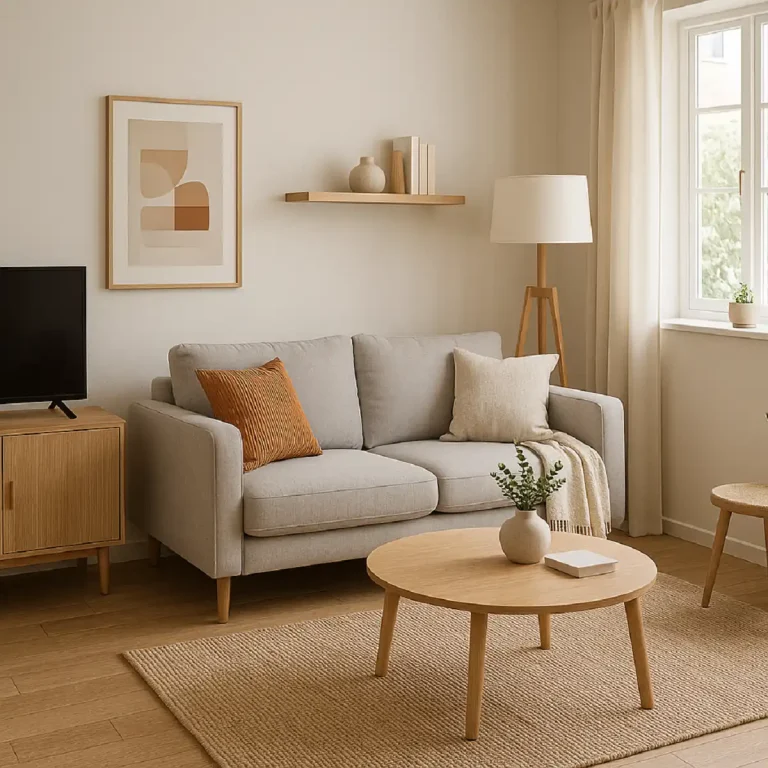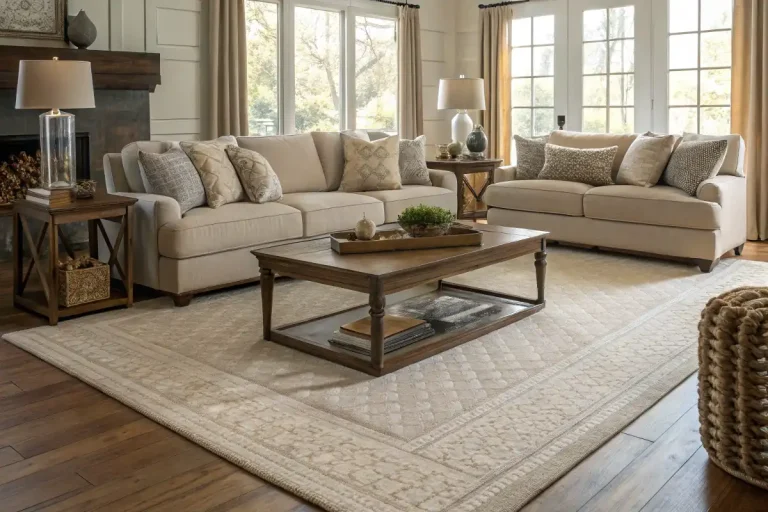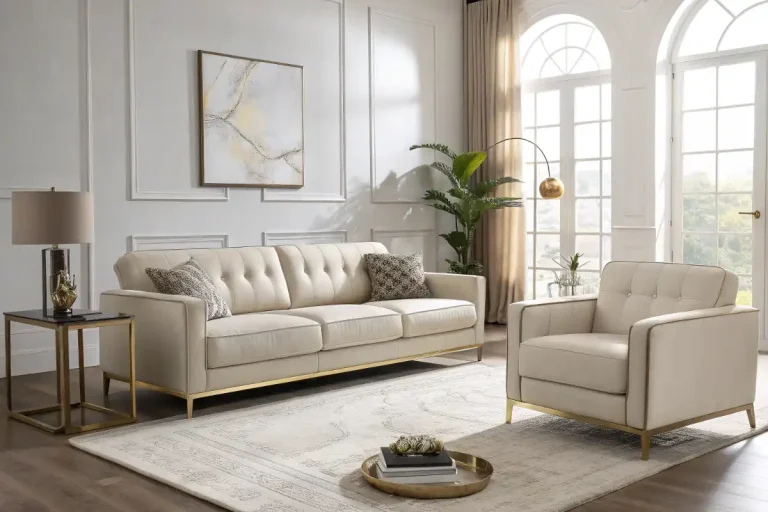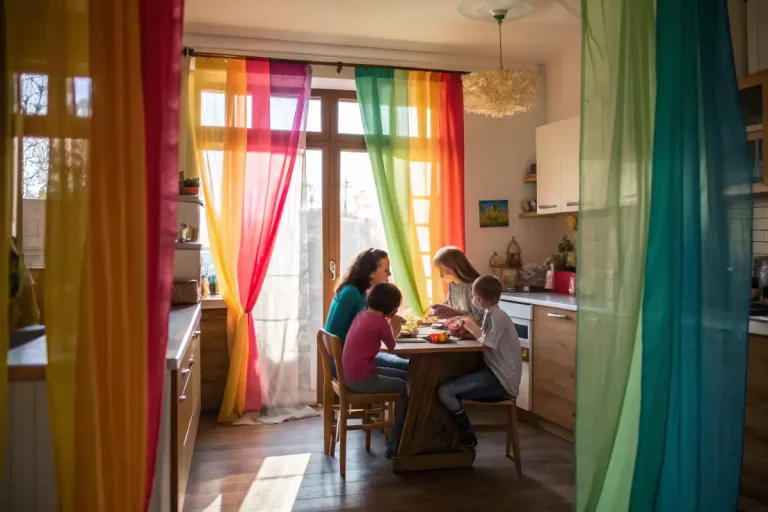Design Living Room Furniture, Budget‑Friendly Furniture for Living Room
The living room is truly the heart of the home – a hub for relaxing, socializing, and even working. In 2025, interior designers emphasize comfort and wellness as much as style. Expect living rooms to blend cozy seating, personalized décor, and eco-friendly materials. For example, Decorilla observes that 2025 trends “reflect a customized blend of aesthetics and comfort” and a continued commitment to sustainability. This guide will help you choose the right furniture pieces and design strategies – from core seating and tables to style formulas and smart features – so your living room is beautiful and functional for modern life.
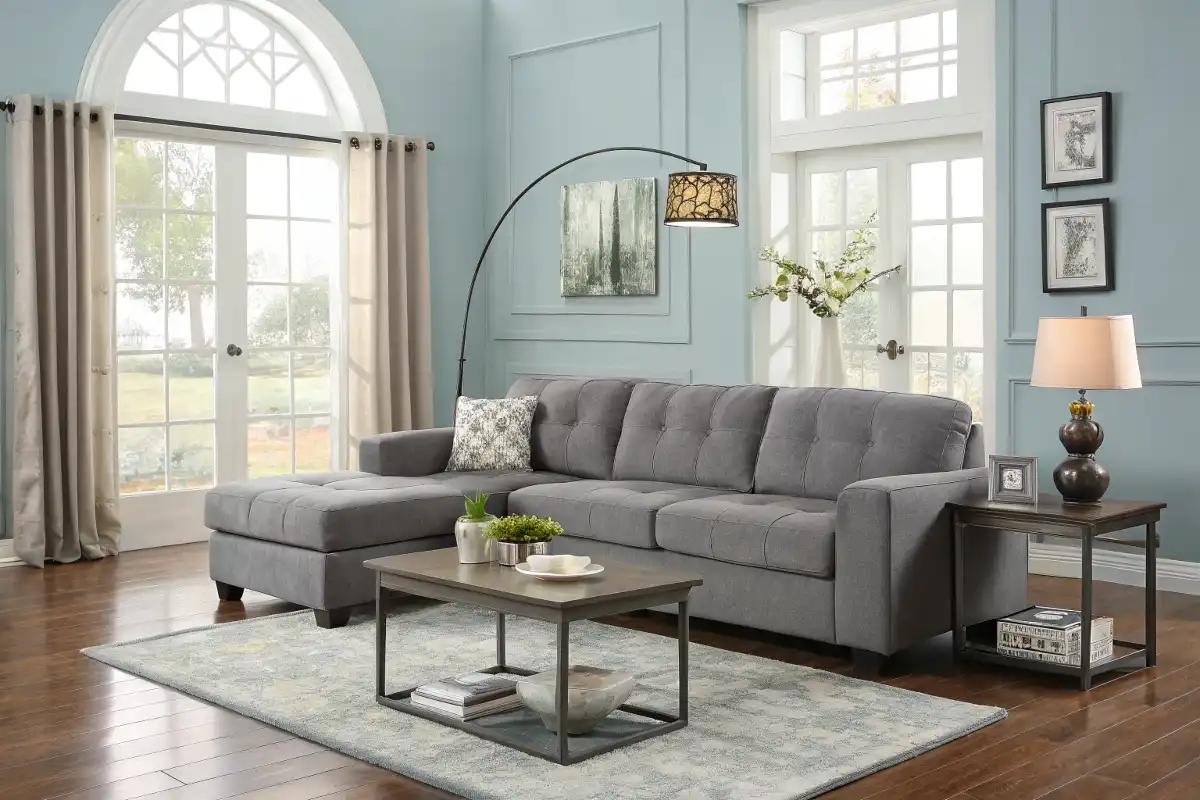
Table of Contents
Core Living Room Furniture Pieces
Seating Essentials
Comfortable, well-scaled seating is the foundation of any living room. Sofas and sectionals should balance form with function. Look for deep-seat couches with high-resilience foam and plush upholstery; as one trend report notes, “comfort is king” in 2025 living rooms, with “plush sofas” and oversized cushions defining inviting spaces. Sectionals and modular sofas are popular for flexibility – they can be reconfigured as needed. (Urban Natural even points out a “modular sofa” offers “endless options to grow and change in comfort and style”.) Accent chairs add personality and extra seats – choose heights and fabrics that complement your sofa. For example, an elegant armchair might be about three-quarters the height of the sofa for visual harmony (coordinated seating sets). If space is tight, consider benches or ottomans: they double as seating or a surface and can tuck neatly under a console or table when not in use. Recliners and ergonomic chairs are also on trend, especially models with built-in lumbar support or heating for wellness. (compact living room solutions)
Tables: Function Meets Style
Tables anchor seating areas and must be both useful and well-proportioned. A coffee table should be about two-thirds the length of your sofa and roughly the same height as the sofa cushions (or just 1–2 inches shorter). This sizing keeps items within easy reach without overwhelming the space. For example, if you have a 90″ sofa, a coffee table around 60″ long would be ideal. Leave about 12–18″ of clearance between the sofa and the table so it’s accessible yet not a tripping hazard.
- Coffee Table: ~2/3 sofa length; about sofa seat height. Materials like marble, glass, or wood define the room’s style.
- Media Console/TV Stand: Aim for a unit slightly wider than the TV for balance. Many modern media cabinets include built-in tech and storage (see below) and use mixed materials (wood, fluted glass, metal). For example, Lifestyle Furniture notes 2025 TV consoles often have “built-in wireless charging, LED lighting, and even hidden compartments for tech gadgets”.
- Side/Accent Tables: These should be about the same height as sofa arms (for ease of use) or slightly lower. Combine materials for interest – e.g. a rattan-and-ceramic side table or travertine-top accent table can complement the main furniture. Side tables are great places to integrate chargers or small lamps.
Storage & Display
Efficient storage keeps a living room organized without looking cluttered. Use bookshelves or open shelving units to display books, art, and plants. Open wood or metal shelves feel modern and airy. Accent chests or storage cabinets (with drawers or doors) hide blankets, games, and media accessories. Look for soft-close drawers and non-toxic finishes on these pieces.
Media Units/TV Stands: Contemporary media cabinets do more than hold a TV. Many now double as tech hubs. Some even offer modular, customizable designs – for example, certain units include interchangeable shelves or drawer modules. According to lifestylefurniturehomestore, “TV cabinets with built-in storage for books, decorative items, or even a home bar provide added functionality”. Choose a console that lets you route cables internally or includes cord covers, so electronics stay out of sight and your layout looks clean.
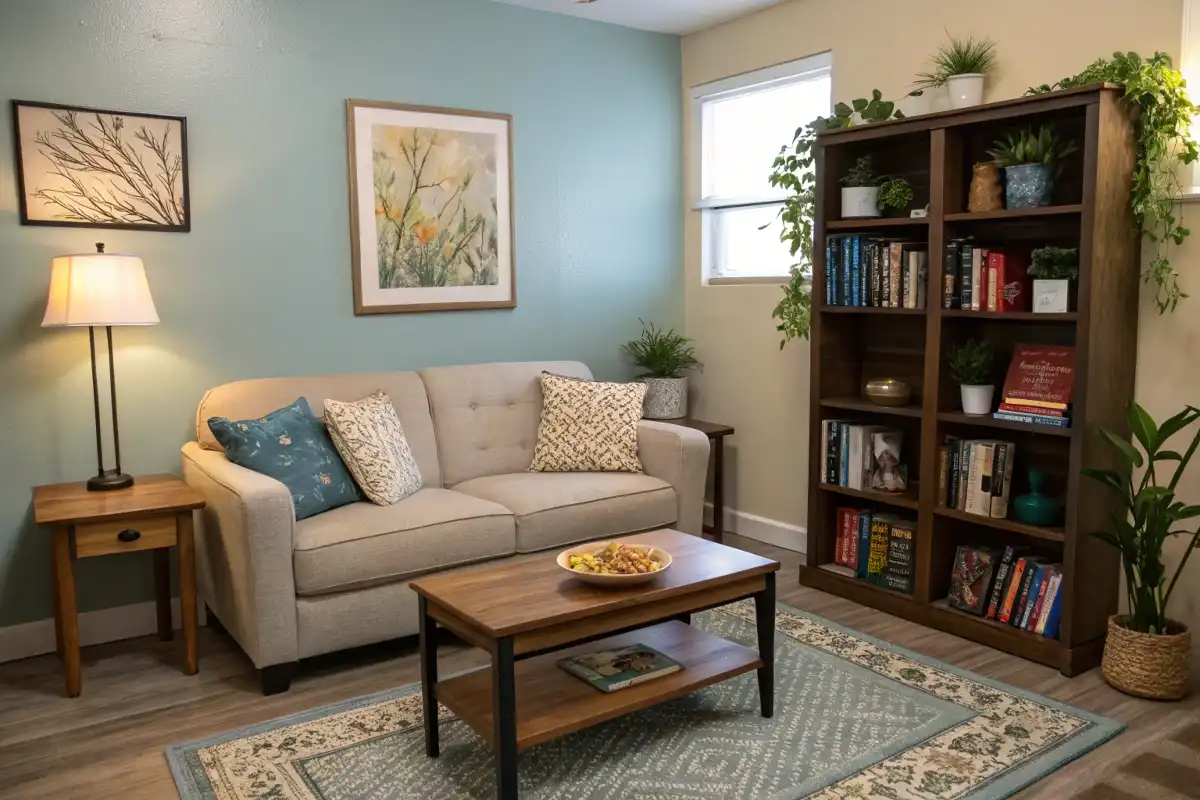
Design Styles & Aesthetics: Actionable Formulas
Modern Art Deco (Luxury with Edge)
Art Deco is making a comeback as a vibrant style option. Elle Decor describes Art Deco in 2025 as “bold, glamorous” and everywhere in design. Key elements include geometric symmetry, rich jewel-tone colors, and lots of metallic accents (gold or chrome). When done right, Art Deco living rooms feel opulent but not fussy.
- Look: Start with a curved velvet sofa as your focal point (e.g. in emerald or sapphire tones) – its smooth lines add softness. Pair it with a geometric coffee table in brass or blackened metal. Incorporate a sunburst mirror or art piece on a wall to echo the classic Deco motif. The image of a sunburst pattern is indeed a trademark of Deco design.
- Pro Tip: Keep walls and large surfaces in neutral or monochrome shades (black, gray, cream) so the furniture’s bold colors and shiny details pop. Add small touches of extra luxe – for example, a marble accent table or brass-trimmed lighting – to complete the glamorous feel.
(In visual terms, one could think of the room’s “visual weight” as 70% the sofa, 25% the coffee table, 5% the accent mirror or art – essentially one strong statement piece (the sofa) anchored by complementary metallic and mirror elements.)
Vibrant Maximalism (Bold & Personal)
Maximalism – the “more is more” approach – is also hot for 2025. Instead of playing down your style, this lets you layer colors, patterns, and textures for a lively, eclectic space. Decorilla notes that maximalist design “embraces the idea that more is more, with layers of colors, patterns, and textures composing a rich, vibrant space”.
- Rule of 3 Scales: A helpful guideline is to mix patterns in three sizes. For example:
- Large pattern: an oversized floral or geometric sofa or rug, (perfect rug selection)
- Medium pattern: a secondary pattern on an ottoman or curtains,
- Small pattern: accent pillows or a throw with a detailed motif.
This scaling keeps the look intentional.
- Balance with Neutrals: Because maximalism can get busy, balance the visual load. Use a solid, neutral wall color (e.g. soft beige or charcoal) to ground the furniture. Break up patterns with solid-colored pieces or metallics. Decorilla emphasizes “the key to successful maximalism is balance” – a well-done space will feel “curated and cohesive” rather than chaotic.
- Colors & Décor: Don’t shy away from bold jewel or earthy tones – deep emerald greens, rich purples, or warm terra cotta are in vogue. Fill bookshelves and tables with personal objects, art, plants, and books. Each piece adds to the story of the room. As long as elements are thoughtfully arranged, a maximalist living room will feel energetic and unique, and invite conversation and exploration.

Creating a Functional and Inviting Space
Smart Furniture & Tech Integration (2025 Must-Haves)
Furniture is getting smarter. Many pieces now include built-in technology to make life easier and keep a sleek look. For example, 2025 TV consoles often incorporate hidden wireless chargers for phones, LED lighting, and neatly stowed cables. New Look Furniture predicts smart, tech-integrated furnishings (like tables with wireless charging and voice-controlled lamps) will be “staple[s] in modern homes”.
- Wireless Charging & Ports: Look for coffee or side tables with Qi charging surfaces built in. Media units are beginning to hide charging pads under tempered glass or open slots. Many new consoles also include USB outlets and Bluetooth speakers inside the cabinet.
- Cable Management: Seek furniture with integrated cable channels or magnetic panels to conceal wires. This keeps your setup tidy (no spaghetti of cables on the floor) and preserves that clean, minimalist style.
- Smart Lighting: LED lighting strips or puck lights embedded in shelves/table edges can change color or brightness via app or voice. For instance, tables and shelves that react to Alexa/Google voice commands let you dial in warm or cool light with no wall switches. This layered, mood lighting approach allows you to set the perfect ambience for any time of day.
- Multifunction Consoles: Some units even double as organizers – for example, TV cabinets with built-in storage for books or barware, or armoires that include a fold-out desk. These multi-use designs maximize utility in style.
Hybrid WFH Layouts
Many homes now need the living room to support work-from-home. The key is flexibility so the space can shift between office and lounge. One clever solution: position a slim console desk behind the sofa. A narrow console (about 120 cm wide × 35 cm deep) can act as a makeshift desk. Pair it with a height-adjustable stool or office chair that tucks under when not in use. This creates a discrete workstation by day that blends away by evening.
Design experts suggest using dual-purpose furniture for hybrid living. For example, studioforma notes that hybrid workers favor “furniture that serves multiple purposes” – like a desk that doubles as a dining table or a bookshelf with integrated storage for office supplies. If space is very limited, a lap desk on the sofa or a mobile folding table can move easily. Good lighting (task lamps) and ergonomics (monitor risers, keyboard trays) will help the work area feel deliberate. The result: a living room that’s both welcoming and work-ready.
Sustainability That Matters
Eco-conscious consumers demand transparency and real impact from their furniture. The trend is beyond marketing buzz – verified credentials are a must. In fact, market research shows the US sustainable furniture industry reached about $12.72 billion in 2025, reflecting strong demand. Studies find 97% of buyers say they pay attention to eco-certifications, and a large share of younger consumers are willing to pay more for green options.
- Certifications & Materials: Look for third-party labels. The Forest Stewardship Council (FSC) on wood, GreenGuard for low-toxicity finishes, GOTS for organic textiles, and Cradle-to-Cradle for overall product sustainability. Veranda highlights this advice: check for “FSC for wood and Cradle to Cradle for overall brand sustainability”. Many manufacturers are using reclaimed wood, recycled metals, and formaldehyde-free finishes to meet these standards. Choosing these means your furniture has documented eco-credentials.
- Durability & Circular Design: Favor furniture built to last. Heirloom-quality pieces with sturdy joinery often include repair services or spare part availability. Some brands design couches with modular cushions or covers so you replace worn parts instead of the whole sofa. Industry reports note flat-pack and modular connectors are on the rise, allowing components to be easily separated for refurbishment. Also seek out retailers with take-back or recycling programs – they will remanufacture or recycle your piece at end-of-life.
- Brand Practices: Shop small and local where possible. According to ASID, Gen Z and Millennials are increasingly “prioritizing shopping small and local for furniture” to support artisans and reduce waste. This often means vintage or handcrafted finds that already exist, cutting down on new production. When buying new, prefer companies with transparent sourcing and sustainable factory practices. As experts advise, “seek out materials like reclaimed wood, recycled metals, and non-toxic finishes”.
In short: make sustainability part of your criteria, not an afterthought. Certified, long-lasting, repairable furniture is better for the planet and aligns with 2025’s value-driven style.
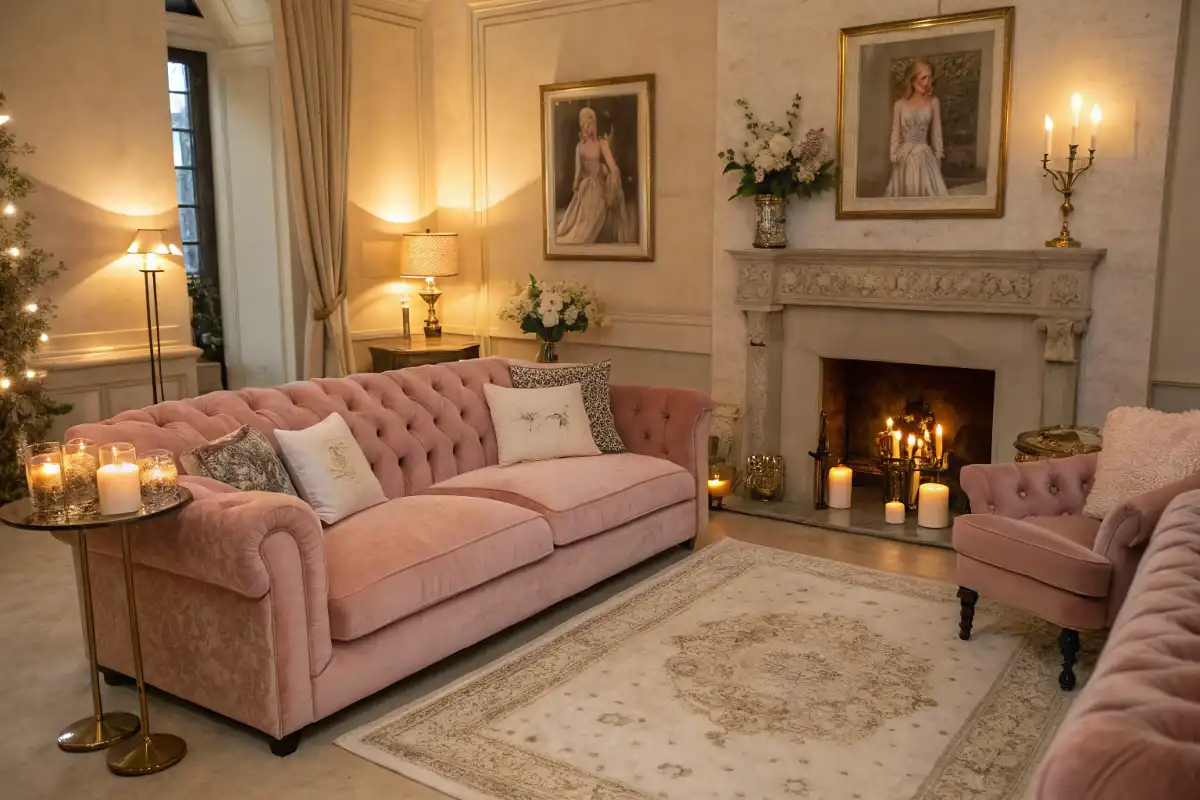
Wellness-Centric Furniture (Post-Pandemic Priority)
Health and comfort go hand-in-hand in a modern living room. Furniture can actively promote well-being:
- Performance Fabrics: Choose upholstery with antimicrobial or stain-resistant technology. Brands like Crypton (EcoFresh) or fabrics with nano-tech coatings repel bacteria and spills, helping keep the room clean. These are great for families with kids or pets. (While we don’t have a specific study to cite here, this is a recognized product feature in many modern sofas.)
- Ergonomic Seating: Support your body. Select recliners or lounge chairs with adjustable lumbar support, heat or massage features, and even zero-gravity positions if possible. Such chairs help reduce back strain and improve circulation during long sitting. Again, this aligns with the comfort-first mindset – deep, cushy seating that feels good for hours is in vogue.
- Air Quality: Cleaner air = better health. New IKEA products illustrate this trend: their STARKVIND side table combines a table and an air purifier. It quietly filters out PM2.5 particles, allergens, and VOCs while blending into your décor. Other furniture pieces with built-in HEPA filters or activated carbon units are emerging. (Even if your furniture isn’t a purifier, adding a compact purifier or air-cleaning plants near seating can make a difference.)
- Circadian Lighting: Don’t overlook lighting’s impact on wellness. As one lighting expert explains, “Natural light’s warm color stimulates the brain, elevates your mood, keeps you alert… and regulates your body’s circadian rhythm”. In practice, use bright cool-white lights during the day and warm dimmable lights in the evening to mimic daylight patterns. Layer ambient ceiling lights, floor lamps, and table lamps to match activities. For example, bright white task lights near a reading chair, plus warm wall sconces or LED strips for evening relaxation. This lighting strategy helps your body maintain healthy sleep-wake cycles and creates a soothing environment.
By integrating these wellness features, your living room becomes not just pretty, but truly nurturing – a home sanctuary that supports your physical and mental health.
Conclusion
The perfect living room for 2025 balances style, utility, sustainability, and well-being. Key takeaways from this guide:
- Proportion & Layout: Use scale formulas (e.g. coffee table ≈2/3 sofa length; 12–18″ clearance around tables) for a harmonious layout. Float furniture in conversational groupings, and allow clear walkways.
- Style Blending: Don’t be afraid to mix aesthetic formulas. Create a signature Art Deco statement with curved velvets and brass, or layer a carefully curated maximalist mix of colors and patterns.
- Eco First: Prioritize certified, eco-friendly furniture. Modular designs and local artisans can help reduce waste. Remember, investing in quality and repairability is both stylish and planet-friendly.
- Smart & Hybrid: Embrace flexible, tech-savvy furnishings. Integrate wireless charging, smart lights, and hidden storage. Plan for a blended living/work area by using multi-use pieces (e.g. a console-desk).
- Comfort & Health: Finally, make comfort and wellness top priorities. Deep, supportive seating; cleanable, antimicrobial fabrics; and layered lighting will keep the space cozy and healthful for all who use it.
Your living room isn’t just furniture and décor – it’s a living ecosystem of your lifestyle. By choosing pieces thoughtfully and following these 2025-forward tips, you’ll create a space that looks great, feels great, and lasts a long time.
FAQ
Q: What are the key living room furniture trends for 2025?
A: Comfort, wellness, sustainability, and smart functionality. Popular styles include Modern Art Deco and Vibrant Maximalism, with modular, multifunctional pieces and eco-friendly materials.
Q: How big should a coffee table be?
A: About two-thirds the length of your sofa and roughly the same height as the seat (or 1–2 inches shorter).
Q: What is a modular sofa?
A: A sofa made of separate sections that can be rearranged or expanded for flexibility and long-term use.
Q: How can I add sustainability to my living room?
A: Choose FSC, GreenGuard, GOTS, or Cradle to Cradle certified furniture, use reclaimed or recycled materials, and support brands with take-back programs.
Q: Can I work from home in my living room?
A: Yes. Use dual-purpose furniture like a console desk behind the sofa or a media unit with a fold-out workspace.
Q: What defines the Modern Art Deco style?
A: Curved velvet sofas, geometric brass tables, sunburst mirrors, and bold jewel tones with metallic accents.
Q: How do I style a maximalist living room?
A: Mix large, medium, and small patterns, balance with neutral walls, and layer colors, textures, and personal décor thoughtfully. (luxury home furnishings)
Q: What smart features are in living room furniture?
A: Built-in wireless charging, USB ports, LED lighting, cable management, and voice-controlled smart lighting.
Q: How does furniture support wellness?
A: Through ergonomic design, antimicrobial fabrics, air-purifying tables (like IKEA’s STARKVIND), and circadian rhythm lighting.
Q: Why is hybrid design important?
A: It allows the living room to easily switch between relaxing and working, maximizing function in modern homes.

